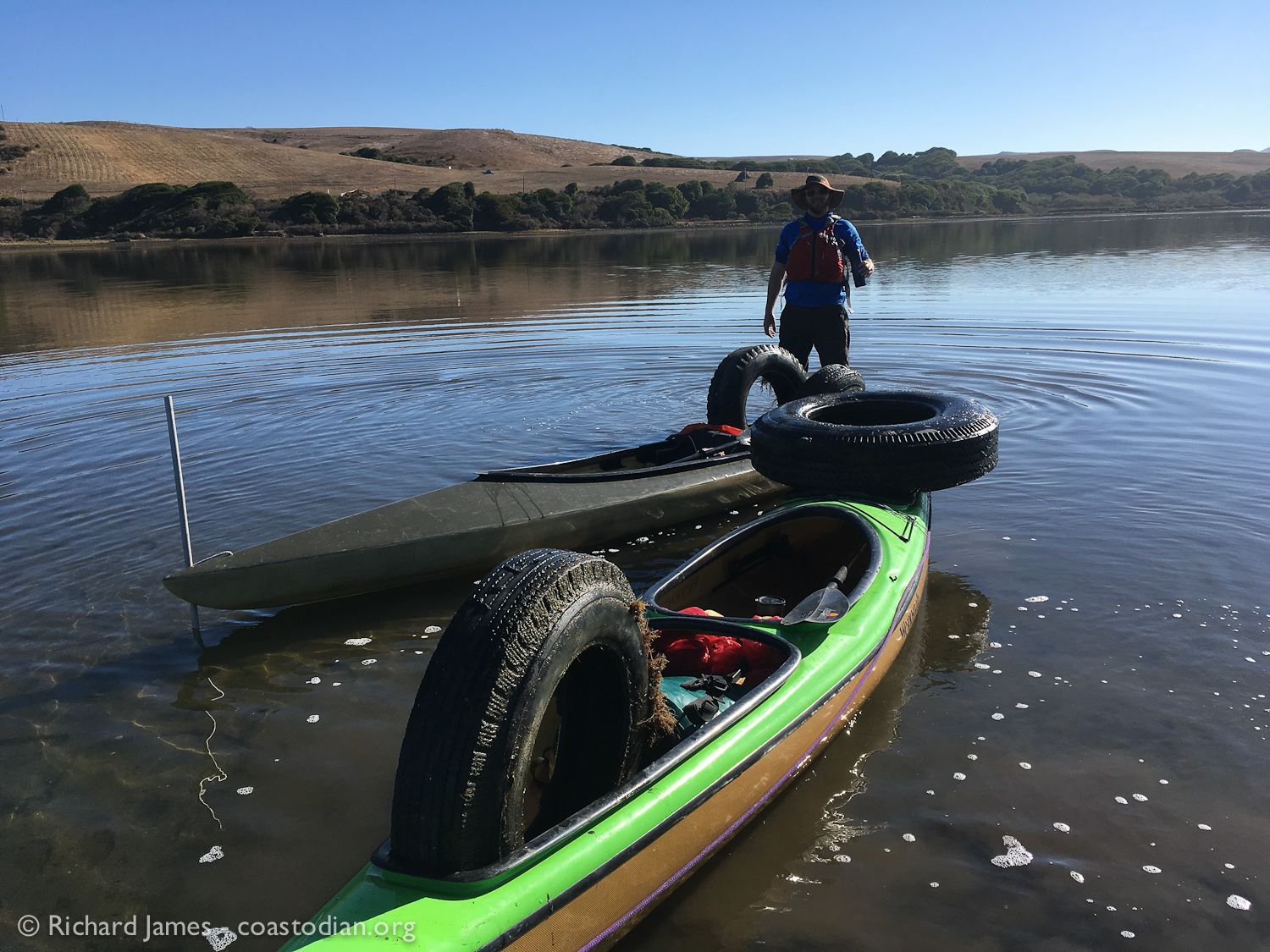Click on the words above “Respect Tomales Bay – TBOC makes a huge effort…” to see this entire post.
Ten days ago while walking the mudflats at the mouth of Walker Creek I came across a most interesting find.
A large amount of abandoned oyster racks and grow out bags.
Now, those of you that follow my efforts on Tomales Bay might say, “Richard, what is so interesting about abandoned oyster racks and grow out bags? You have been finding and ranting about that stuff for a few years now…yawn.”
Well, let me tell you what is so interesting about this particular find.
As you may know by now, a series of unpermitted fences meant to redirect the flow of Walker Creek have blighted The Bay for upwards of 15 years. You can read about these structures here, here, here and here for starters.
.
Here are two images showing one such fence before removal, as it was on 17 January, 2015.
.
Those fences were removed last year before an epic series of storms graced the area with much needed rain, rain that made its way down Walker Creek with a full head of steam. Instead of being shunted to the north by a wall of plastic bags, PVC pipes, concrete pilings, plastic-coated copper wire and zip-ties – all that lovely water was once again allowed to run freely.
The huge volume of water that poured naturally through what had for 15 or more years been a mudflat uncovered an enormous amount of abandoned iron racks and plastic bags (many filled with dead non-native oysters). This debris was left there after the 1982 epic flood that buried much, if not all of the oysters being farmed by International Shellfish Corporation.
Of course I made photographs and recorded Lat/Lon waypoints of this find.
I shared this information with all the current growers (including TBOC, on whose lease this legacy debris had remained hidden all these years), as well as some of the alphabet soup of agencies responsible for caring for the precious coastline – CFGC, CFDW, CCC amongst them.
.
Map showing debris and where it was located (click on map for larger image)

.
Unable to lift out this mess myself due to an injured back (from lifting non-oyster farming debris out of the bay a month prior), I gave this information to the growers and agencies and hoped that someone would take the ball and run, before the tides once again covered it back up.
The next day, most, if not all of the TBOC crew was onsite pulling this gear out of the mud, piling it along the newly formed channel. How awesome is that!
A big thank you to TBOC for stepping up to remove gear that was on public land which they lease, though not their gear. They recovered 223 bags, some still with dated tags from 1980 on them, as well as many hundreds of pounds of sharp, rusty iron racks.
Let’s hope other growers on the bay follow this lead and remove legacy gear from public land they now lease, littered with gear from years ago. Ideally the agencies tasked with regulating aquaculture on public lands will pitch in to help current growers deal with messes left by those that came before them.
.
Debris recovered and removed by TBOC!

.
Image showing location where legacy debris was removed by TBOC staff. Red line shows location of former unpermitted creek-deflecting berm.

.
Image showing location where legacy debris was removed by TBOC staff. Red line shows location of former unpermitted creek-deflecting berm.

.
Removing the vast amount of Oyster Farming Legacy (OFL – rhymes with awful) is not as simple as heading out and picking up this stuff. Some permits are needed in order to do needed cleanup work in the coastal zone. Permits that TBOC had in hand to effect the (almost) complete removal of the last of their creek-deflecting structures.
.
What must now happen is for the Fish & Game Commission and Department of Fish & Wildlife to step up and take responsibility for their growers of days gone by (some under their watch, some before their watch began) and do the necessary leg work to secure permits for the removal of the remaining OFL blighting Tomales Bay, as well as make the removal happen. Growing shellfish along the coast is OK by me, as long as it is done truly sustainably, by those practicing Authentic Stewardship.
Now more than ever we need to protect the environment.
Undoing the damages from past practices, as well as incorporating Best Management Proactices (BMPs) into leases and redesigning the cleanup fund escrow system to remove the numerous conflict of interest issues, as well as to give it teeth make good sense. This is especially important in light of the new application to practice aquaculture in Tomales Bay that has been recently submitted.
.
Below are images showing some of the debris still left all around Tomales Bay by growers of yesteryear needing to be removed by Authentic Stewards.
.
Some of the many dozens of sharp, rusty iron racks littering Tomales Bay, presenting a danger to all who boat there.

.
Some of the many dozens of sharp, rusty iron racks littering Tomales Bay, presenting a danger to all who boat there.

.
Four telephone-sized treated pilings and ten or so sharp rusty racks, all abandoned in The Bay long ago.

.
140+ treated pilings abandoned long ago near Tom’s Point.

.

Century old bat-ray fence abandoned long ago, now causing sedimentation in the southern bay as well as providing hard substrate for the invasive oyster drill to colonize upon as well as lay many, many thousands of eggs. These oyster drills prey upon the threatened native Olympia Oyster
.








